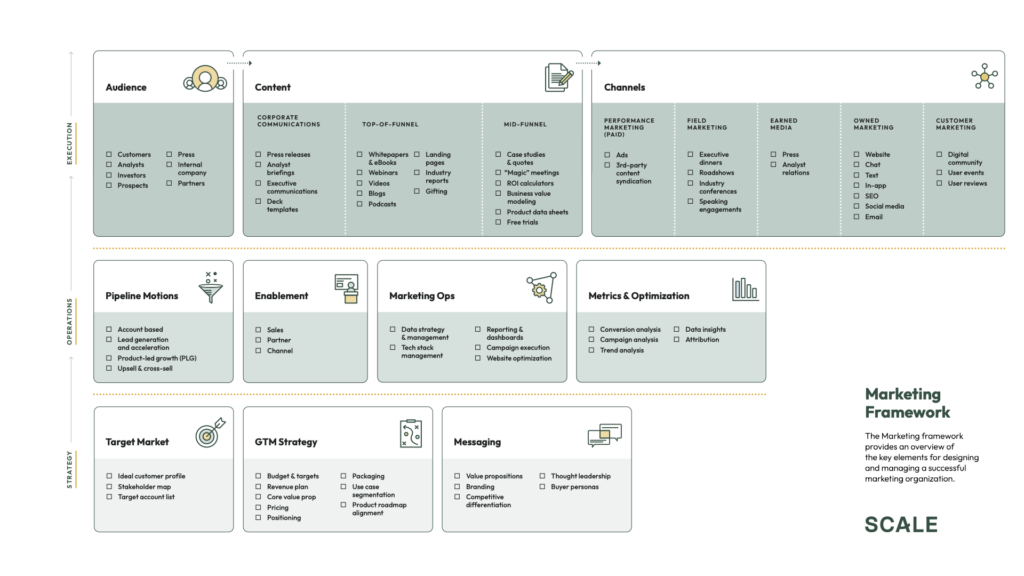Let’s be honest: the remit of the “marketing” function, at least as it exists in B2B tech companies, is exceptionally broad. The marketing leader has to support everything from brand to corp comms, from demand gen to messaging; as compared to peers in sales and other organizations, a marketing leader’s responsibilities are substantially wider and diverse.
To help out founders and early-stage marketing leaders, we decided to create the Scale Venture Partners Marketing Framework. Our goal was to consolidate, in a single document, the many strategies, activities, tools, and personnel marketing leaders need to successfully meet the demands placed on them by the CEO and the Board.
Along the way, we had to make several controversial editorial decisions. Internally, we had many spirited discussions about what to include and how to present it. In fact, with the exception of the “Target Market” box, we moved everything in the strategy and operations rows around at least once. In the end, though we feel like this is a solid starting point for marketing teams building their strategies, we know that this is only a first draft and will evolve over time.
Our framework is broken into three fundamental layers: strategy, operations, and execution.
Strategy layer:
- We start all of our frameworks with the target market because it is the cornerstone upon which every other decision is made.
- GTM strategy development is often owned by marketing and built in conjunction with other functions. The target market informs the creation of that strategy, and together they guide the rest of elements in the framework.
- We originally placed messaging in the “GTM Strategy” box. However, because messaging is entirely owned by marketing and can make or break a company’s GTM, we agreed that it would be crazy not to give it its own box. Here, we establish it as one of the three foundational pillars of marketing.
Operations layer:
- Looking across the universe of other published marketing frameworks, we were surprised to see that no one included the concept of pipeline motions. To us, that felt like an injustice–the only question was where to put it. We originally had it in the “GTM Strategy” box and it probably would have been fine had we left it there. However, we felt like it made slightly more sense in the operations layer, since it is only after you complete the steps in the strategy layer that you decide on your pipeline motion(s). Similar to the strategy elements, though, the pipeline motion will affect everything else you do in your operations and execution layers.
- The rest of the operational items comprise straightforward but important elements of any successful marketing operation.
Execution layer:
- Our CMO EIR, Maria Pergolino, inspired a breakthrough in how we represent marketing execution. In our view, the best execution process works in three steps: identify the audience you want to target, decide on the type of content that will best reach them, and select the channels. Though we were hardly the first to come up with this structure, we found that it is often applied only to demand gen. By contrast, we consider this workflow to be the best practice for any form of marketing. As a result, our design incorporates all elements of the CMO’s remit, including field marketing, analyst relations, etc.
We encourage you to print out the framework and tick off any boxes for which your team already has robust processes, resources, and guidance. For any items left unticked, start to think about how you incorporate them into your plans for next year. Finally, if you think we are missing anything or have a different way of laying out the elements of your marketing organization, we would love to hear from you.
